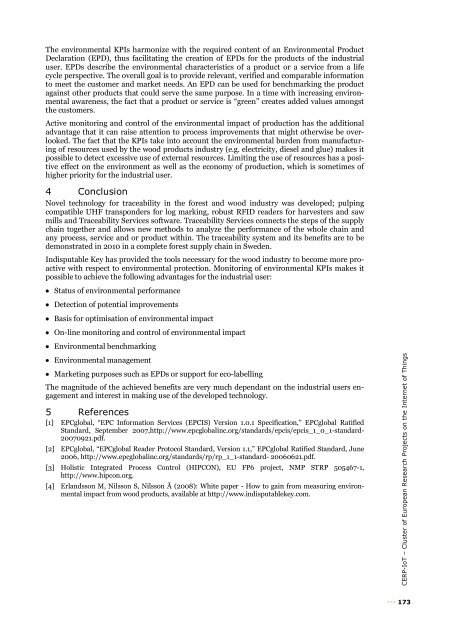Vision and Challenges for Realising the Internet of Things
Vision and Challenges for Realising the Internet of Things
Vision and Challenges for Realising the Internet of Things
You also want an ePaper? Increase the reach of your titles
YUMPU automatically turns print PDFs into web optimized ePapers that Google loves.
The environmental KPIs harmonize with <strong>the</strong> required content <strong>of</strong> an Environmental Product<br />
Declaration (EPD), thus facilitating <strong>the</strong> creation <strong>of</strong> EPDs <strong>for</strong> <strong>the</strong> products <strong>of</strong> <strong>the</strong> industrial<br />
user. EPDs describe <strong>the</strong> environmental characteristics <strong>of</strong> a product or a service from a life<br />
cycle perspective. The overall goal is to provide relevant, verified <strong>and</strong> comparable in<strong>for</strong>mation<br />
to meet <strong>the</strong> customer <strong>and</strong> market needs. An EPD can be used <strong>for</strong> benchmarking <strong>the</strong> product<br />
against o<strong>the</strong>r products that could serve <strong>the</strong> same purpose. In a time with increasing environmental<br />
awareness, <strong>the</strong> fact that a product or service is “green” creates added values amongst<br />
<strong>the</strong> customers.<br />
Active monitoring <strong>and</strong> control <strong>of</strong> <strong>the</strong> environmental impact <strong>of</strong> production has <strong>the</strong> additional<br />
advantage that it can raise attention to process improvements that might o<strong>the</strong>rwise be overlooked.<br />
The fact that <strong>the</strong> KPIs take into account <strong>the</strong> environmental burden from manufacturing<br />
<strong>of</strong> resources used by <strong>the</strong> wood products industry (e.g. electricity, diesel <strong>and</strong> glue) makes it<br />
possible to detect excessive use <strong>of</strong> external resources. Limiting <strong>the</strong> use <strong>of</strong> resources has a positive<br />
effect on <strong>the</strong> environment as well as <strong>the</strong> economy <strong>of</strong> production, which is sometimes <strong>of</strong><br />
higher priority <strong>for</strong> <strong>the</strong> industrial user.<br />
4 Conclusion<br />
Novel technology <strong>for</strong> traceability in <strong>the</strong> <strong>for</strong>est <strong>and</strong> wood industry was developed; pulping<br />
compatible UHF transponders <strong>for</strong> log marking, robust RFID readers <strong>for</strong> harvesters <strong>and</strong> saw<br />
mills <strong>and</strong> Traceability Services s<strong>of</strong>tware. Traceability Services connects <strong>the</strong> steps <strong>of</strong> <strong>the</strong> supply<br />
chain toge<strong>the</strong>r <strong>and</strong> allows new methods to analyze <strong>the</strong> per<strong>for</strong>mance <strong>of</strong> <strong>the</strong> whole chain <strong>and</strong><br />
any process, service <strong>and</strong> or product within. The traceability system <strong>and</strong> its benefits are to be<br />
demonstrated in 2010 in a complete <strong>for</strong>est supply chain in Sweden.<br />
Indisputable Key has provided <strong>the</strong> tools necessary <strong>for</strong> <strong>the</strong> wood industry to become more proactive<br />
with respect to environmental protection. Monitoring <strong>of</strong> environmental KPIs makes it<br />
possible to achieve <strong>the</strong> following advantages <strong>for</strong> <strong>the</strong> industrial user:<br />
Status <strong>of</strong> environmental per<strong>for</strong>mance<br />
Detection <strong>of</strong> potential improvements<br />
Basis <strong>for</strong> optimisation <strong>of</strong> environmental impact<br />
On-line monitoring <strong>and</strong> control <strong>of</strong> environmental impact<br />
Environmental benchmarking<br />
Environmental management<br />
Marketing purposes such as EPDs or support <strong>for</strong> eco-labelling<br />
The magnitude <strong>of</strong> <strong>the</strong> achieved benefits are very much dependant on <strong>the</strong> industrial users engagement<br />
<strong>and</strong> interest in making use <strong>of</strong> <strong>the</strong> developed technology.<br />
5 References<br />
[1] EPCglobal, “EPC In<strong>for</strong>mation Services (EPCIS) Version 1.0.1 Specification,” EPCglobal Ratified<br />
St<strong>and</strong>ard, September 2007,http://www.epcglobalinc.org/st<strong>and</strong>ards/epcis/epcis_1_0_1-st<strong>and</strong>ard-<br />
20070921.pdf.<br />
[2] EPCglobal, “EPCglobal Reader Protocol St<strong>and</strong>ard, Version 1.1,” EPCglobal Ratified St<strong>and</strong>ard, June<br />
2006, http://www.epcglobalinc.org/st<strong>and</strong>ards/rp/rp_1_1-st<strong>and</strong>ard- 20060621.pdf.<br />
[3] Holistic Integrated Process Control (HIPCON), EU FP6 project, NMP STRP 505467-1,<br />
http://www.hipcon.org.<br />
[4] Erl<strong>and</strong>sson M, Nilsson S, Nilsson Å (2008): White paper - How to gain from measuring environmental<br />
impact from wood products, available at http://www.indisputablekey.com.<br />
CERP-IoT – Cluster <strong>of</strong> European Research Projects on <strong>the</strong> <strong>Internet</strong> <strong>of</strong> <strong>Things</strong><br />
173
















